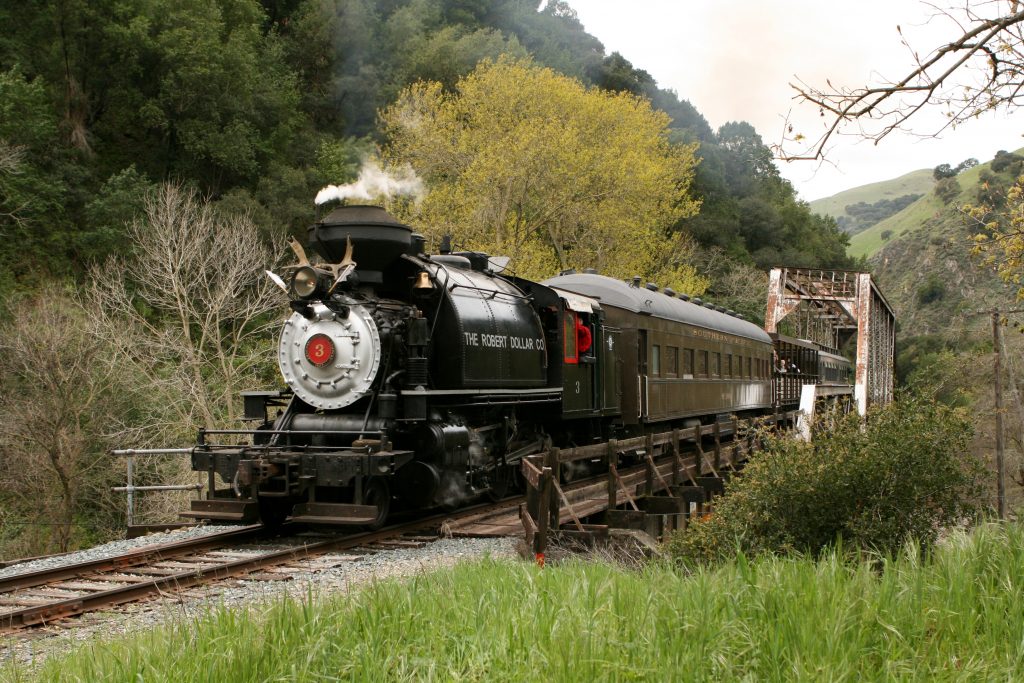A railroad museum where the exhibits come to life!
The Pacific Locomotive Association, Inc., a 501(c)(3) nonprofit organization, operates Niles Canyon Railway as a living history museum interpreting the importance of our heritage railroads in the development of California and the nation. The purpose of the organization is to preserve the physical aspects and atmosphere of Pacific Coast railroading during the period from 1910 to 1960. Our mission is to develop and operate a working railroad museum for the benefit of the general public.
The museum is designed to increase public education, enjoyment, and appreciation of the significance of America’s western railroads by:
- Operating historic railroad equipment using standard railroad practices for train crews, signaling, block operations, and equipment maintenance.
- Preserving the atmosphere of railroads in small-town America before the 1960s by connecting the historic communities of Sunol, the Niles District of Fremont, and eventually Pleasanton.
- Providing educational programs for schools, civic organizations, and community events.
- Instructing the public in railroad history, tradition, and the evolution of rail transportation technology.
The Pacific Locomotive Association also has railroad artifacts on display and interpretive educational exhibits at the Sunol Depot.
History of Railroads in Niles Canyon
The First Transcontinental Railroad Era (1862-1869)

The history of trains in Niles Canyon dates back to the building of the original transcontinental railroad. The first Western Pacific Railroad Company (formed in 1862) started construction in San Jose towards Sacramento. It built twenty miles of track that reached into Alameda Creek canyon in 1866. Its first passenger excursion entered the canyon on October 2 of that year. Construction was halted shortly thereafter, however, because of disagreements between the railroad’s contractors and its financiers.
In September, 1869, four months after the famous golden spike ceremony at Promontory Summit, Utah, the Central Pacific Railroad completed the transcontinental rail link between Sacramento and the San Francisco Bay, finishing the track through the canyon.The CP had acquired the Western Pacific and other local railroads and built track to connect them at a waterfront terminal at Alameda Point.
The Central Pacific constructed a freight terminal at the west end of the canyon and a town quickly sprang up around it. The town was named for Addison C. Niles, a prominent judge and former railroad attorney.
The Southern Pacific Era (1869-1984)
The Central Pacific eventually became part of the Southern Pacific railroad system. Over the years, the SP invested heavily in a main line to the north through Benicia and Martinez. The tracks in the canyon became a secondary main line.
Very few rebuilding programs by the railroad left the Niles Canyon line with much of its original cut stone bridge abutments, culverts and retaining walls from the original Western Pacific’s right of way (circa 1865). These unique constructions can still be seen today.
Steam locomotives pulled trains through Niles Canyon for eighty years before diesels took over in the 1950s. In 1984, after twelve decades of railroading in the canyon, the Southern Pacific ceased operating trains on the right-of-way, pulled up the tracks, and deeded the land to Alameda County.
The Niles Canyon Railway Era (1987-Present)

The Pacific Locomotive Association entered into an agreement with the county and began rebuilding the rail line in 1987. Association volunteers worked for over a year on the first part of the track reconstruction between Sunol and Brightside.
On May 21, 1988, almost 122 years after the first Western Pacific excursion, the Pacific Locomotive Association brought railroad passenger operations back to life in Niles Canyon.
Presently, Niles Canyon Railway provides train rides to the public year-round between Sunol, California and Niles in Fremont, California.

